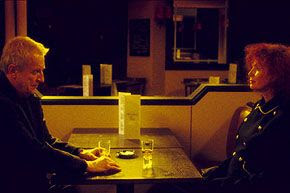Set in depression era Tennessee, this is a whimsical tale of a mysterious old hermit who has an unusual plan for his funeral – he wants it to be a party while he’s still alive.
A grizzled Robert Duvall is the hermit, the kind who’d put up a self made wooden sign stating: “No Damn Trespassing – Beware Of Mule” on the road leading to his rustic house.
From his night sweats we see that Duvall is sick and dying. Knowing he has little time left he goes into the small town he lives on the outskirts of to make arrangements. “About time for me to get low” he tells the local pastor (Gerald McRaney).
A young funeral home employee (Lucas Black) overhears this and tells his boss – a mustached worried wart of a man played beautifully by Bill Murray – that their ailing business may have a possible client.
This is a perfect timing for Murray as he was just talking about how down the death business has been lately. Murray: “What are the odds of a funeral home going broke? We have a business that everybody on earth needs. If you can’t make that work it’s got to be you. Right? And yet, I don’t know. What do you do when people don’t die?”
Everybody in town appears to have heard rumors and gossip of all sorts about Duvall’s past. He wants it known that everybody who has such stories should come tell them at his “funeral party.” Duvall in turn will tell his story.
Sissy Spacek is an old flame who appears to be charmed by the old codger, but like everybody else she is tight lipped about what went down back in the day.
As the film began with a flashback to a burning house with a silhouette of somebody on fire jumping out of an upstairs window we have some hints about what will be revealed.
GET LOW has a lot of folksy charm, but it feels like it needed to be a lot more fleshed out. It sails sweetly on the strength of its performances largely Duvall and Murray, but it doesn’t take the risks necessary to give it the emotional power it sorely lacks.
As an African American preacher that Duvall wishes would attend his “going away” affair, Bill Cobbs unfortunately reminds us that this is a whitewashed version of the ‘30s in the South – one with no detectable racism.
The depression era really has no baring on the plot - it could've taken place anywhere at any time, but as it is loosely based on a true story that happened in 1938 Tennessee, that's how we have it.
Also the idea that the town folk would open up at the funeral party and the stories would fly never comes to pass. The climatic event contains a wonderfully delivered confessional speech by Duvall, but after that the ending peters out.
Still, Duvall is always an appealing actor and he never plays a false note as this cantankerous character, and Murray’s masterful portrayal of a broken-down-yet-still-chugging-along-salesman oaf makes every scene he’s in as absorbing as they are amusing.
Spacek and Black are fine in their roles, but both are broad strokes as supporting players which would've benefited from just one more rewrite by the screenwriters (Chris Provenzano and C. Gaby Mitchell).
It’s a light drama sprinkled with light comedy that gets a little too carried away with its own whimsy. That’s okay though, I have a feeling that many audiences will get carried away with it.
More later...



















